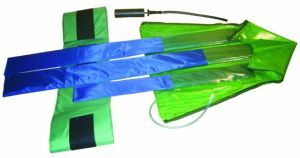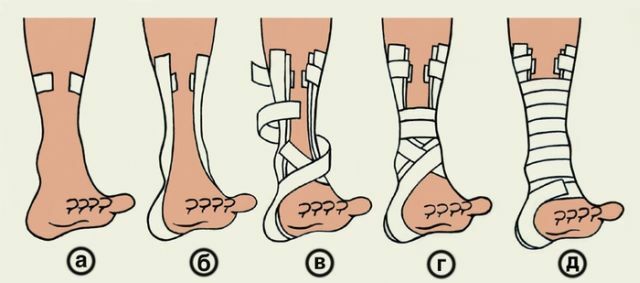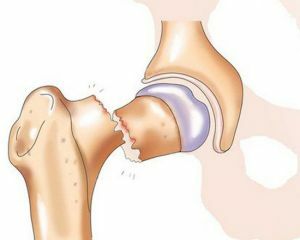
Fracture of the femoral neck - this is a very dangerous damage to the , which can cause death. In most cases, such fractures occur at the age of more than 65 years.
In young people, they are usually associated with serious accidents and other severe injuries. In the elderly, such fractures are usually the result of osteoporosis.
Article Contents
- joint Anatomy
- injury mechanism
- injury Classification
- Symptoms
- injury diagnostic techniques
- Conservative treatment Surgical treatment of injuries
- osteosynthesis Endoprosthesis
- Rehabilitation
- Video: Who threatens a hip fracture, how to cure it?
Anatomy of the joint
The joint has certain anatomical features that affect the appearance of such fractures:
- the femoral neck is located inside the joint cavity, it is covered with a capsule, but not protected by the periosteum;
- the cervical bone of the hip extends from the body at an angle of 115-135 degrees: the less this is indicative, the greater the load, and this increases the risk of fracture;
- the main arteries that are responsible for the blood supply of the cervix and femoral head, pass along the lower edge of the joint capsule;
- to the head of the hip bone suits only one artery, but in older people it overgrows.
Trauma Mechanism
As a rule, the femoral neck breaks down under the influence of the traumatic force , which is directed along the axis of the lower limb. This can happen when a person falls on a straight leg. If the traumatic force acts perpendicularly, the pelvic bones usually break, but sometimes the femur also suffers.
Even in developed countries, about 30% of patients die within a year after receiving such an injury. Impossibility to perform a person's operation entangles him to bed, which leads to the development of complications - chronic illnesses worsen, the work of the heart worsens, pneumonia develops.
The causes of fractures vary significantly depending on the age of the patient. Fracture of the femoral neck in the elderly is usually due to a decrease in the strength of bones - osteoporosis. Bones affected by this disease can break even with an ordinary fall. Also, the risk factors include:
- , oncological diseases;
- neurological pathology;
- low physical activity;
- irrational food;
- impaired vision.
Young patients usually receive similar injuries due to serious accidents, falls from a height.
 What signs of a broken finger indicate that you should immediately call a doctor and do not self-medicate.
What signs of a broken finger indicate that you should immediately call a doctor and do not self-medicate.
How to superimpose the tire Cramer on the lower limb you can find out here. Also in the material on the rules of wearing a device.
Classification of injury
There are quite a few varieties of such fractures. On the site of the onset:
- medial - occurs in the area of attachment of the joint capsule to the thigh;
- lateral - located near the head of the hip bone near the joint.
Localization can identify the following types of injury:
- cubaputitalny - in this case, its line is located directly near the head of the thigh;
- transcervical - located in the middle of the neck of the thigh;
- basisservical - its line is located at the beginning of the neck of the thigh.
The closer the fracture is to the head of the hip, the higher the risk that it will not grow together. With such a trauma, the blood supply to the head is severely impaired.
On the fracture angle, the following varieties are distinguished:
- & lt; 30 °;
- 30-50 °;
- & gt; 50 °.
The higher this value, the greater the threat, than the bones will not grow together.
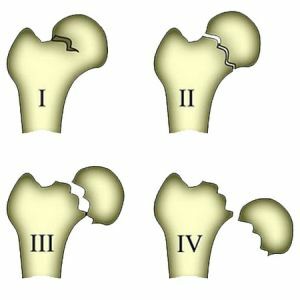
Depending on the displacement of fragments and the completeness of the fracture, the following are distinguished:
- incomplete without bias;
- full without bias;
- full with partial offset;
- full with full offset.
The greater the displacement of fragments, the lower the chances that the fracture will grow together.
In addition, distinguish the fractures of the femoral neck distinguish the different types of displacements:
- Varus - in this case, the head is shifted down and inside.
- Valgus - there is a shift up and out.
- A punctured - in this case, one piece of bone is pounded into the other.
Also, the fracture is closed or open.
Symptoms of injury
With this fracture, a person usually complains of painful sensations that increase when trying to lift or turn a leg. Sometimes it can be turned outward, there is a shortening of the limb. In addition, the main symptoms for fracture of the femoral neck include the following:
- Violation of motor activity. As the joint loses its configuration, a person usually can not move and even stand.
- Pain sensations in the groin. As a rule, the pain has no pronounced character. Sometimes a person does not notice the moment of fracture, because acute pain sensations are absent.
- No pain in rest. She returns again when trying to move her foot.
- Turning the foot outward. This symptom with a hip fracture can be seen in a relaxed state - it is judged by the position of the knee and foot.
- Inability to deploy the leg inside. This symptom is associated with the peculiarities of the attachment of muscles.
- Axial load pain .When pressure or effleurage of the heel, pain appears.
- Shortening of the leg. Characteristic for varus fractures, as the angle between the femur and neck decreases.
- Subcutaneous hematoma. May develop several days after the injury.
Diagnostic Techniques
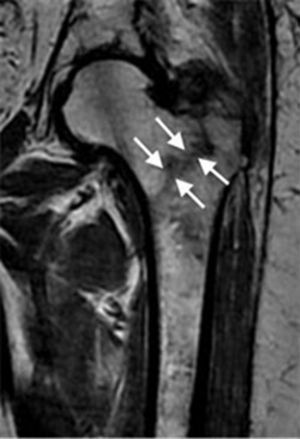
On the photo of MRI in the baseline of a cervical fracture of the femoral neck
It is usually not difficult to make the correct diagnosis. The specialist will do this after a clinical examination.
To determine the diagnosis is assigned radiography.
In certain situations, in order to clarify the nature of the displacement, computerized tomography can be used.
In difficult cases, the diagnosis can be confirmed by magnetic resonance imaging or scintigraphy, but usually this does not occur.
Treatment of hip fracture is a complex process that is not always effective.
Today conservative or operative therapy can be applied.
Conservative treatment of
It is usually used in the following situations:
- with punctured fractures;
- with fractures of the lower part of the femoral neck;
- if a person is in serious condition and can not be operated on.
For conservative treatment, immobilization of the patient is carried out with a circular gypsum bandage for 3-5 months. From the first day of the imposition of the system, a person must perform respiratory gymnastics and raise the upper body with a special frame.
For the elderly, often the consequences for a hip fracture are very severe and often result in a fatal result.
The most common complications of conservative therapy are:
- pneumonia;
- pressure sores;
- psychoemotional disorders;
- deep vein thrombosis.
Surgical treatment of trauma
If there are no contraindications to surgery, surgery for a hip fracture should be performed as soon as possible. If this procedure can not be done immediately, then skeletal traction is first applied.
Before fixation of bone fragments, reposition is usually carried out, that is, comparing them with each other. Sometimes, to increase the chances of fusion, the reposition is not anatomical, in which the original position of the bone is restored, but the special one - in this case, the fragments are displaced so as to facilitate the fusion of the fracture.
Two main methods are used for surgical treatment.
Osteosynthesis
The operation is a combination of bone fragments with special metal structures. Perform such types of osteosynthesis:
- with Smith-Petersen tri-lobed nails - they are slaughtered in the neck of the thigh with a special hammer;
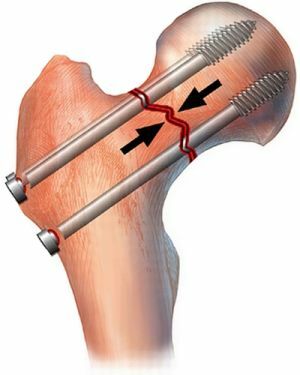
In the picture, osteosynthesis with screws using
- femoral neck fracture with three screws is considered a more reliable method and is usually used in young people;
- with the dynamic femoral screw - in this case a rather bulky metal structure is screwed into the femur.
The main drawback of this operation for fracture of the femoral neck is the risk of non-bony, therefore this procedure is not performed in people over 65 years of age.
In addition, osteosynthesis can lead to post-traumatic osteoarthritis and avascular osteonecrosis. There is also a risk of infection during surgery and development of pulmonary embolism.
Endoprosthetics
The operation is a replacement for the prosthesis of the head of the hip bone and the acetabulum. Such an operation is usually performed in the following cases:
- elderly patient;
- significant displacement of fragments;
- high fracture complexity;
- presence of several fragments;
- aseptic necrosis of the femoral head.
There are several types of this operation:
- endoprosthetics with total prostheses - in this case the total prosthesis replaces the head and neck of the bone, as well as the acetabulum of the pelvis;
- monopolar prosthesis - used solely to replace the head and neck of the thigh;
- bipolar prosthesis - in this case the head of the prosthesis is located in a special capsule, which has a point of contact with the acetabulum, thereby reducing the wear of the joint.
Operation of endoprosthetics can also lead to serious health consequences - thromboembolic complications, infection, development of dislocation, nerve or blood vessel damage, loosening or wear of implants, different length of legs.
Rehabilitation
After removal of gypsum and intensive treatment, it is necessary to proceed to the rehabilitation stage after fracture of the femoral neck.
Young people are much easier to recover, while the in elderly people is likely to be fatal. Rehabilitation after such an injury involves performing a set of exercises, the purpose of which is to restore the functions of the leg, as well as the whole body.


